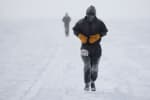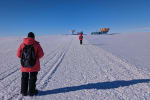Running a full marathon is one thing (and one that most of us find hard to wrap our heads around), but running a marathon at the South Pole? Now there’s some conviction! Every year, the South Pole hosts a full marathon, along with a half marathon and other races, and sometimes IceCube members are among […]
IceCube’s first citizen science project a success
Last year, the “Name that Neutrino” project was launched, which called on volunteers from the public to help classify signals from neutrinos—tiny, ghostlike particles—for the IceCube Neutrino Observatory at the South Pole. The project was hosted on Zooniverse, the largest web-based research platform that invites novices and science enthusiasts alike to contribute to ongoing research […]
Week 2 at the Pole
A bright sun and clear skies were just the ticket for capturing this image of the IceCube Lab (ICL) at the South Pole last week. The photo was actually taken at 3:00 am! Athough the sun’s out all the time now, that early hour happened to be ideal for outdoor lighting conditions. This summer is […]
Week 1 at the Pole
The new year started off on a quiet note at the South Pole. Last week, with a well-behaved IceCube detector and many holiday celebrations behind them, the winterover crew enjoyed a relatively quiet week, with some nice weather and perhaps a little more free time on their hands. They spent some of that time continuing […]
Week 52 at the Pole
Everyone at the South Pole station congregated outside last week for a nice holiday group photo. While the temperatures at the Pole are normally their warmest in December and January, it was still cold out there. Hard to tell from the photo as there are plenty of folks not wearing hats and a few here […]
PhD theses granted – Fall 2023
We congratulate the following PhD graduates who successfully defended their thesis in the fall of 2023: Mike Kovacevich Jeffrey Lazar Barbara Skrzypek Benjamin Smithers […]
Week 51 at the Pole
The South Pole station remains a busy place these days. Last week saw lots of activity for IceCube’s winterovers and summer crew, from unpacking cargo and upgrading equipment at the IceCube Lab (ICL) to continued ERT training as well as multiple seasonal celebrations. Festivities included a summer solstice observance, a karaoke/talent show, and a special […]
Week 50 at the Pole
What a busy week! IceCube’s winterovers did some housecleaning and equipment testing at the IceCube Lab, had continued ERT training (including handling patients and doing X-rays in the clinic), and gave a presentation on IceCube to a packed galley for the station’s Thursday Night Science Lecture. Last week also saw the long-awaited arrival of the […]
Thai engineer joins the IceCube Upgrade project
Thai engineer Chana Sinsabvarodom was recently selected to work on the IceCube Upgrade project, which will install seven more densely instrumented strings of light sensors near the center of the IceCube array at the South Pole. The IceCube Upgrade will significantly enhance IceCube’s sensitivity to lower-energy neutrinos, improve the fidelity of all past and future […]
IceCube search for low-energy GeV neutrinos from gamma-ray bursts
As one of the most powerful classes of explosions in the universe, gamma-ray bursts (GRBs) have long been considered a possible astrophysical source of neutrinos—tiny “ghostlike” particles that travel through space and large amounts of matter unhindered. These high-energy neutrinos are of particular interest to the IceCube Neutrino Observatory, a gigaton-scale neutrino detector at the […]








